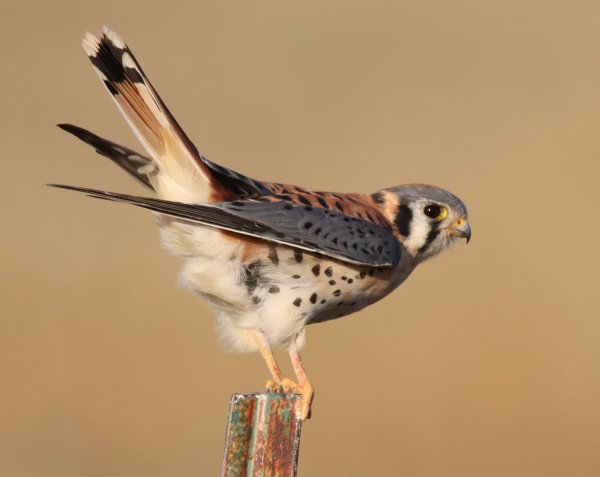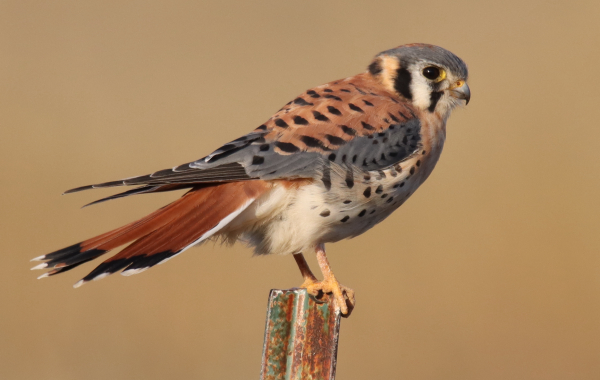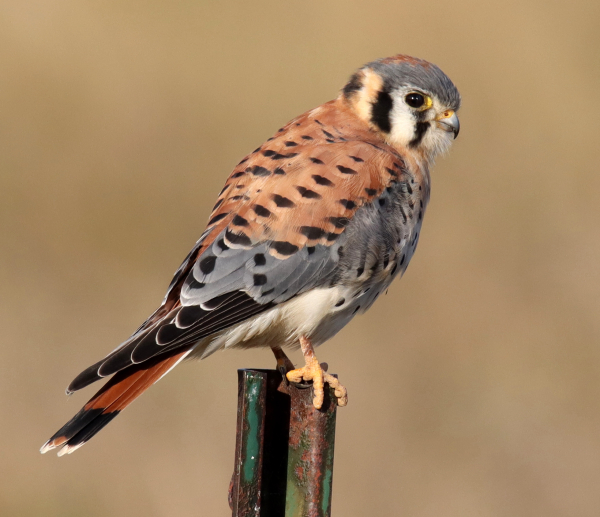This has been a remarkable year for bird photography for me, and while we can rarely plan or expect good photos when focusing on birds, it sure is exciting when a photo opportunity develops. Last Wednesday provided a beautiful fall afternoon with bountiful sunshine, but the farther west I drove toward Bismarck, the windier it became. Nonetheless, I enjoyed seeing a variety of raptors, a big flock of Sandhill Cranes, and much more – but worthy photo ops escaped me. I had time aplenty, so drove a dozen miles off-course to a location near the Missouri River where there is an area of Badlands outcrops and ridges.

Aside from being a remote location with unusual landscape features for the east side of the river, it is an area where Peregrine Falcons, Merlins, and American Kestrels funnel during late September, so maybe a Merlin or Kestrel could be seen, or even a late Peregrine. A few golden-leaved cottonwood trees brightened the way, but after making my way down the winding road through the Badlands area, I drew a zero for birds. I reversed and as I negotiated a tight curve around a steep butte, on my right side I caught the image of a male American Kestrel bent over as it was feeding on the top of a weathered fence post.
I couldn’t stop there for safety reasons, and I didn’t want to spook the kestrel, but after driving to an open area I took a U-turn and double-checked my photo settings quickly before returning to the kestrel snack spot. Although I scrutinized the area, the mini-falcon was nowhere to be seen. Again, beyond the Badlands butte I reversed course, but this time found the kestrel perched along the fenceline. I eased into position, and took some initial photos as the kestrel was trying to keep its balance while facing into the stout east-southeast wind while watching for potential prey.
After a minute or so, the kestrel flew low before me and landed on the road to grab an insect. Thereafter this photo episode turned into a game of follow the leader, with the kestrel leading the way. Each time the kestrel perched, the beautifully colored mini-falcon spent an extended period hunting as it faced into the wind. Although aware, it seemed to be unconcerned with my mobile blind, which made me inch a little closer each time it moved to a new perch after a hunting strike.

I was thrilled to take a series of portrait photos in the perfect afternoon sunlight, with the muted colors of the fall grass providing a uniformly colored background that helped to “pop” the mini-raptor apart from its surroundings. To further emphasize the uniform background color, I changed my camera’s aperture from f8 to f6, and checked the effect on the camera’s LCD screen on the back of the camera body – just as I hoped, it was a pleasing uniform tan hue.
Using the Av setting on my Mode dial, this change of aperture automatically increased the shutter speed from 1/640 to 1/1000 of a second, which could be a big plus – if the falcon provided a little action. Indeed, all the action I was getting was away from the perches, as it flew to catch insects on the road and return to another perch. Even so, once as the kestrel lifted off from the ground it banked high into the wind, creating a dramatic falcon flare that left an indelible falcon image in my mind that emphasized its long pointed wings, long tail, compact body, and rounded head.

Although I wasn’t in position to try for flight images, I was more than happy with the impressive portraits I was getting that showed the varied colors, spots, and other markings of the male kestrel’s plumage. After about a half-hour without a trace of another vehicle or person in the area, I bid the fine falcon well and turned back down the road with hopes of finding another photo subject. But about a mile away, I came to my senses – kinda – and thought: “Lighting conditions are just right, and where am I going to find another bird as trusting as the kestrel.” I turned back, and even though the colorful falcon hadn’t provided an action photo, it didn’t mean that was out of the question. Returning to the scene, I pulled into position beside and a bit behind the American Kestrel as if I never left and resumed photographing in the exceptional late afternoon sunlight.
Then it happened! Nothing too spectacular, but sometimes a little bit can be a lot. Pressing its face into the strong wind, the kestrel seemed to spy new prey and leaned forward in anticipation for a takeoff. I was already on high alert for action, so as the kestrel seemed to lose balance, its tail tipped up in reaction and I managed one photo during the peak of that balancing position, and another as it leveled off again with its wings slightly opened – and that was it! Did I get it?
The kestrel immediately took flight to grab a roadside bug, so I quickly checked the camera’s LCD screen to see how the photos turned out, if at all. Bingo, I couldn’t have hoped for better photos under the circumstances, and after viewing the images later on my big screen laptop computer, I was quite thrilled with the second photo that I took as the kestrel regained its balance and was prepared for flight. That photo really caught the essence of a falcon, or what we tend to romanticize as a falcon, bent forward with its wings ready to take off.

It made me imagine how we would react to the colors of this smallest North American falcon if a kestrel was much larger, sized to be the biggest North American falcon. Sometimes we kind of overlook kestrels as fairly common little bug eaters, but they catch a variety of prey including mice, voles, birds, lizards, and snakes. But if they were the size of a female Gyrfalcon, watch out! Big and colorful too. Even though this American Kestrel was a male, females are more falcon-like as far as coloration goes; and obviously, a female kestrel is now elevated on my list of birds I’d like to photograph at an advanced level. I’ve managed to take some nice signature photos of males and females before, but these images of this male are the best by far – to date.
Spending time with a bird like this always provides me with a birder’s high, and I must point out the importance of my decision to return to the kestrel for the second photo session, which provided the action sequence and the best photos. This male American Kestrel was truly an “ambassador of its species,” an individual that trusts you enough to permit you to take your best photos and share them with others so they can appreciate the beauty and majesty of the species, and perhaps it will help someone to better appreciate all birds. There’s nothing quite like spending time observing and photographing with an avian ambassador – gracias amigo! Keep looking for your next “ambassador,” and enjoy photographing during the fall season.
Article and photographs by Paul Konrad
Share your bird photos and birding experiences at editorstbw2@gmail.com